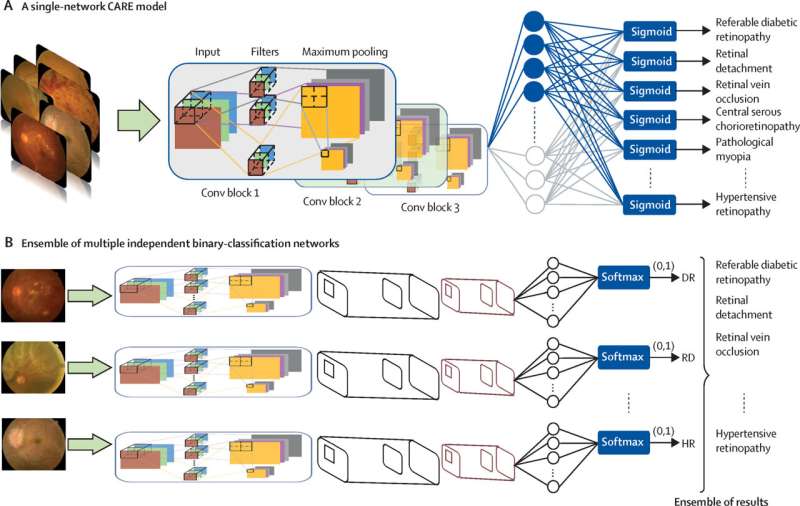Detecting retinal diseases with advanced AI technology


An international group of researchers has successfully applied AI technology to real-world retinal imagery to detect possible diseases more accurately and on a larger scale.
Retinal examinations can detect a number of diseases that affect the eye. Fundus photography is a process of taking photographs of the interior of the eye through the pupil and is a way to screen and monitor such retinal diseases.
The introduction of artificial intelligence (AI) technology to fundus photography has improved the platform and enabled it to detect and monitor retinal diseases on a large scale.
The Comprehensive AI Retinal Expert (CARE) system was developed by an international group of researchers from Sun Yat-sen University, Beijing Eaglevision Technology (Airdoc), Monash University, University of Miami Miller School of Medicine, Beijing Tongren Eye Centre and Capital Medical University.
Associate Professor Zongyuan Ge from the Department of Electrical and Computer Systems Engineering at Monash University and the Monash Data Futures Institute, said the researchers trained a clinically applicable deep-learning system for fundus diseases using data derived from real world case studies, and then externally tested the model using fundus photographs collected from clinical settings in China.
“The CARE system was trained to identify the 14 most common retinal abnormalities using 207,228 color fundus photographs derived from 16 clinical settings across Asia, Africa, North America and Europe, with different disease distributions,” said Associate Professor Ge.
“CARE was internally validated using 21,867 photographs and externally tested using 18,136 photographs prospectively collected from 35 real-world settings across China, including eight tertiary hospitals, six community hospitals, and 21 physical examination centers.”
The researchers expect that CARE would be adopted in medical settings across China and later in the Asia Pacific region.
The performance of CARE was further compared with that of 16 ophthalmologists and tested using datasets with non-Chinese ethnicities and previously unused camera types.
“We also found that the performance of the CARE system was similar to that of professional ophthalmologists and the system retained strong identification performance when tested using the non-Chinese datasets. These findings indicate that the system is accurate when compared to the outcomes of a professional and could allow for more testing to be carried out on a larger scale,” added Associate Professor Ge.
“This research is a step in the right direction for medical and artificial intelligence research. I hope that through this work we can continue to see technological advancements in this space,” said Amitha Domalpally, Director of the University of Wisconsin-Madison Imaging Diagnostic Center.
Source: Read Full Article